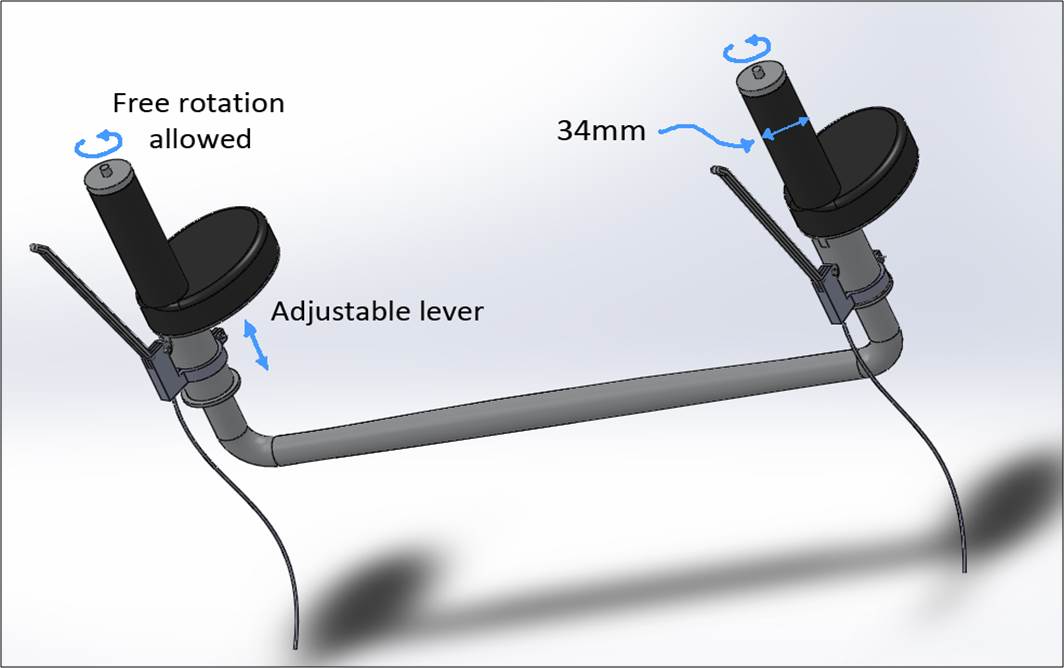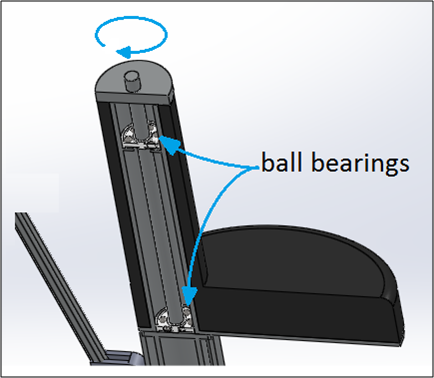Praxis II Detailed Design

A diagram showing the material selection and layering of the grips to maximize shock absorption.
Overview: After the RFP phase, our team selected the following Request for Proposal written by another team: Developing an Arthritis-Friendly Bicycle Handling System. The problem statement we were to solve was the following: “Design an improved bicycle handling system that permits individuals who suffer from arthritis in their wrists and hands to control their bicycles safely and comfortably.”
Team: Fadime Bekmambetova, Rong Guan, and Jingyao (Jason) Li, Toluwanimi Odemuyiwa
Process in Action: The RFP we received fulfilled the problem definition stage of the design process; our team’s goal was to generate various ideas and select and fully develop the design that best fit the criteria. The following two artifacts describe our general design process in starting with a given problem definition statement to an in-progress model of our detailed design:
The poster shows our progress from idea generation of a variety of solutions, to selecting a specific solution using a decision matrix (see bottom-center of the poster). We presented the above artifacts to our assessors to receive feedback on the design, and then continued on with the detailed design. Our final design involved an upright bicycle handlebar with rotating, grips to prevent the rotation of the wrists while steering. In addition, it had adjustable lever brakes to increase the overall mechanical advantage when braking, and shock-absorbing properties in the handle grips to minimize vibration transmission to the hands while cycling. Rong was the innovator of the rotating handlebar, and I was in charge of the material and part selection for the entire handlebar, with input from my teammates.
For the material selection, I came to understand the importance of reference designs when designing a product. I used a U.S. Patent for “Increased Diameter for Arthritic Golf Grips” to determine the optimum layering and material selection for the grips that would maximize shock absorption. In addition, Fadime and I worked on the optimal dimensions for different parts of the bicycle to minimize cost yet maximize comfort. The process I took, and the cost calculations done by the team, can be found here:
Assembly
Engineering Drawings
Some calculations:
https://www.dropbox.com/sh/r6y4cjaspxzjrwj/6Tp6aqNp1Q/Calculations.docx
Team: Fadime Bekmambetova, Rong Guan, and Jingyao (Jason) Li, Toluwanimi Odemuyiwa
Process in Action: The RFP we received fulfilled the problem definition stage of the design process; our team’s goal was to generate various ideas and select and fully develop the design that best fit the criteria. The following two artifacts describe our general design process in starting with a given problem definition statement to an in-progress model of our detailed design:
The poster shows our progress from idea generation of a variety of solutions, to selecting a specific solution using a decision matrix (see bottom-center of the poster). We presented the above artifacts to our assessors to receive feedback on the design, and then continued on with the detailed design. Our final design involved an upright bicycle handlebar with rotating, grips to prevent the rotation of the wrists while steering. In addition, it had adjustable lever brakes to increase the overall mechanical advantage when braking, and shock-absorbing properties in the handle grips to minimize vibration transmission to the hands while cycling. Rong was the innovator of the rotating handlebar, and I was in charge of the material and part selection for the entire handlebar, with input from my teammates.
For the material selection, I came to understand the importance of reference designs when designing a product. I used a U.S. Patent for “Increased Diameter for Arthritic Golf Grips” to determine the optimum layering and material selection for the grips that would maximize shock absorption. In addition, Fadime and I worked on the optimal dimensions for different parts of the bicycle to minimize cost yet maximize comfort. The process I took, and the cost calculations done by the team, can be found here:
- Material/Manufacturing Cost – Toluwanimi and Jason
- Raw Material Cost – Fadime
- Bearings – Selection of the type of bearings to use (Toluwanimi and Fadime)
- Handlebar Frame Decision Matrix – Toluwanimi
- The design sketches or “rough work” for our final product
Assembly
Engineering Drawings
Some calculations:
https://www.dropbox.com/sh/r6y4cjaspxzjrwj/6Tp6aqNp1Q/Calculations.docx
Below is the solid works model of our design:


